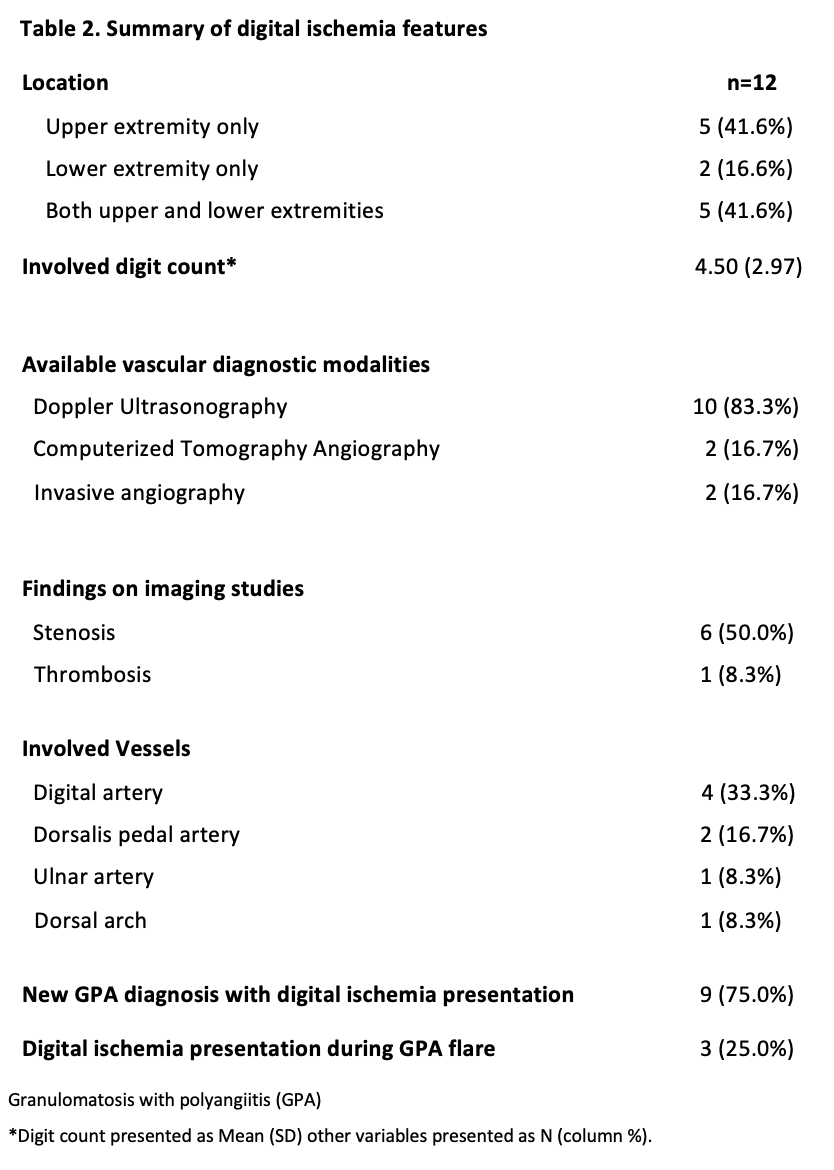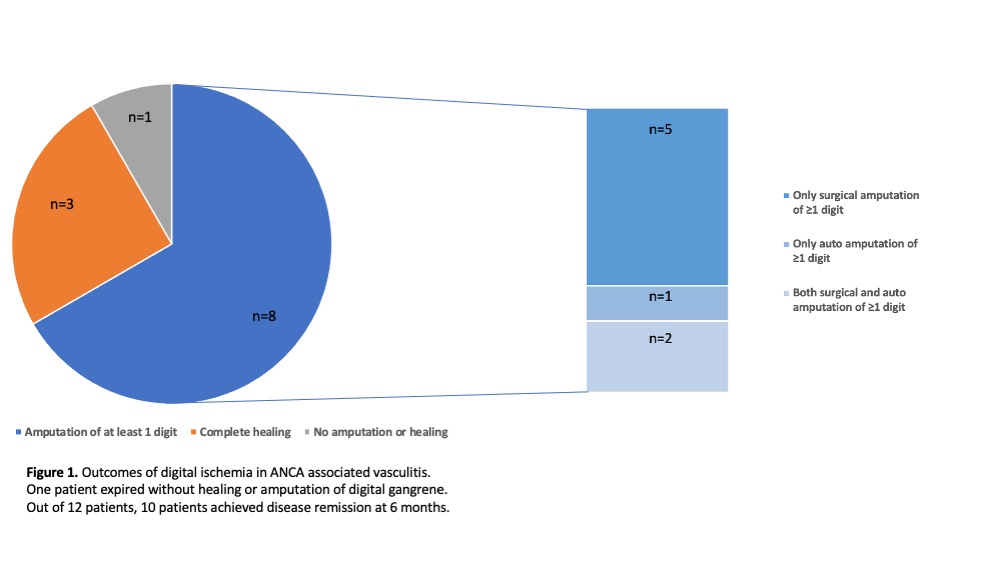Session Information
Date: Monday, November 13, 2023
Title: (1534–1553) Vasculitis – ANCA-Associated Poster II: Epidemiology, Outcomes, & Classification
Session Type: Poster Session B
Session Time: 9:00AM-11:00AM
Background/Purpose: Digital ischemia is a rare, yet severe manifestation observed in AAV. Despite gangrene being a major criterion in the Birmingham Vasculitis Activity Score, this clinical entity is not well described in the literature. We aimed to investigate digital ischemia in AAV.
Methods: This retrospective case series analyzed adult patients with a confirmed diagnosis of AAV and digital ischemia/gangrene, as determined by vasculitis specialists at Cleveland Clinic. Patients without digital ischemia, those diagnosed with a vasculitis other than AAV, and those with digital ischemia related to other causes were excluded from the study. Data collection spanned from January 2002 to January 2023 obtained by chart review.
Results: Twelve patients met the inclusion criteria. The mean age at diagnosis was 52.6 years (SD=18.2), with a male-to-female ratio of 3:1. 33.3% of the patients were active smokers. All patients were diagnosed with granulomatosis with polyangiitis (GPA) and the majority (75%) tested positive for c-ANCA antibodies and PR3 antigen. Other organ involvements at the time of digital ischemia presentation were pulmonary (75%), followed by upper respiratory tract (66.7%), and renal (66.7%) (Table 1).
In terms of digital ischemia, 5 patients (41.6%) had isolated upper extremity involvement, 2 patients (16.6%) had isolated lower extremity involvement, and 5 patients (41.6%) had in both upper and lower extremities. The mean count of involved digits was 4.5 (SD=2.97). Doppler US was the most frequently employed vascular diagnostic modality (83.3%). The most frequently involved vessels were the digital arteries (33.3%). 75% of patients presented with digital ischemia leading to a new diagnosis of GPA, while 3 patients (25%) developed digital ischemia during a disease flare (Table 2).
Treatment strategies for induction therapy were cyclophosphamide CYC in 33.3%, and rituximab (RTX) in 50.0% of patients respectively in addition to glucocorticoids. Maintenance therapy predominantly consisted of RTX (41.7%). Following diagnosis, 66.7% of patients received anticoagulation therapy, primarily with warfarin (62.5%), and 41.7% received anti-platelet therapy (Table 1).
At 6 months, remission was achieved in 10 patients (Figure 1). Surgical amputation was required in 58.3% of patients, 25% experienced autoamputation, while only 25% of patients had complete healing of all digital gangrene. Among the 3 patients who had complete healing; 2 patients were on anticoagulation after developing digital ischemia for a treatment of deep venous thrombosis.
Conclusion: This study provides insights into AAV-associated digital ischemia which is a rare manifestation of this disease. When present, digital ischemia can be the initial presenting feature leading to GPA diagnosis and generally it occurs in conjunction with other organ involvement. Therefore, GPA should be on the differential diagnosis for patients presenting with digital ischemia. Despite most patients achieving remission, a high degree of morbidity occurred with surgical and/or autoamputation of single or multiple digits. Further research is needed to evaluate the role of adjunct treatments such as anticoagulation and anti-platelet for this rare manifestation.
To cite this abstract in AMA style:
Vural A, Zhang C, Yaseen K. Digital Ischemia, a Rare Manifestation in Anti-neutrophil Cytoplasmic Antibody (ANCA) Associated Vasculitis (AAV) [abstract]. Arthritis Rheumatol. 2023; 75 (suppl 9). https://acrabstracts.org/abstract/digital-ischemia-a-rare-manifestation-in-anti-neutrophil-cytoplasmic-antibody-anca-associated-vasculitis-aav/. Accessed .« Back to ACR Convergence 2023
ACR Meeting Abstracts - https://acrabstracts.org/abstract/digital-ischemia-a-rare-manifestation-in-anti-neutrophil-cytoplasmic-antibody-anca-associated-vasculitis-aav/



